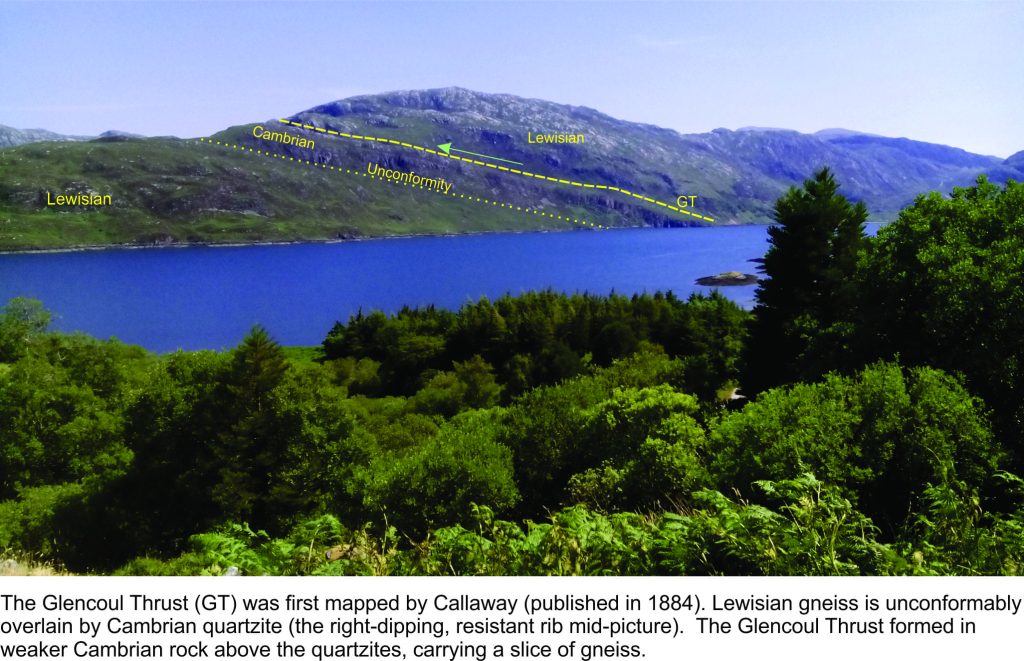
Preamble
I first heard about the Moine Thrust (northwest Scotland) during my undergraduate studies at Auckland University. Our department structural geology guru spoke of it with a kind of reverence – “the principles of thrust faulting discovered in the Scottish Hebrides provide us with the tools to unravel the history of mountain belts. At some time in your career you must visit this iconic geological treasure”. It’s taken 48 years, but here I am, courtesy of my good friend and colleague, Randell Stephenson (Aberdeen University). The Moine – Old Red Sandstone unconformity at Portskerra, Lewisian gneisses and Moine schists near Tongue and Durness, and the Moine Thrust, complete with duplexes and mylonites at Eriboll, Glencoul, and Knocken Crag. And a quick chat with bronzed Ben Peach and John Horne.
My structural geology mentor would be pleased, but might have quipped “what took you so long?”
There have been times in the history of geology when a simple explanation of a complex problem has not only been proven correct – it has revolutionized the way we think about earth processes. The horizontal (or nearly so) transport of thick slabs of the Earth’s crust over large distances is one such problem. We now know that the movement of panels of rock takes place along faults – thrust faults, and that mountain belts past and present owe their existence to a process we refer to as thrusting. The discovery of thrust faults in the latter part of the 19th century is an intriguing tale with two interwoven threads: a scientific thread of astute geological observation and field mapping in the Scottish Hebrides that led to the formulation of a revolutionary idea, and the tension among members of the professional geological fraternity who were confronted not only with a complicated scientific problem, but also had to contend with professional arrogance and institutional bias.
The beginning of such a story is not always easy to pin-point, but we’ll start with one of its main characters, Roderick Murchison, a Scottish geologist who counted among his acquaintances, Adam Sedgwick, Charles Lyell, and Charles Darwin. His forté was the Silurian System (now known to be about 444 – 419 million years old). The Scottish Hebrides contain some of the oldest rocks in Europe – highly metamorphosed Precambrian schists and gneisses as old as 3.1 billion years. In the 18th and 19th centuries they were referred to as the ‘Primitive’ series; they now are collectively called the Lewisian. The Primitives are overlain by younger rocks, including fossiliferous Cambrian sandstones and limestones, but in places these younger rocks are in turn overlain by slices of Primitive metamorphic rocks (Lewisian). Herein lies a fundamental conundrum; the oldest Primitives should not overlie younger fossiliferous rocks. Murchison, during his field excursions in the late 1850s, recognised this sequence of strata, but determined that the Primitives were not as old as previously thought, and in fact were younger than the fossil-bearing rocks.
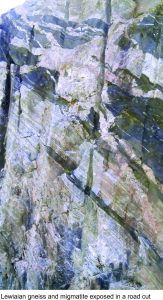
James Nicol, another Scot, a Fellow of the Geological Society of London, and clearly a better field geologist than Murchison, continued the Hebridean researches and discovered that there is a significant break in the stratigraphy, in particular between the fossiliferous beds and the primitive metamorphic rocks. In other words, Murchison was incorrect in his interpretation that the whole sequence of strata continued, one group of rocks upon the other, in an unbroken sequence. It seems Murchison took exception to this, and for Nicol it became a case of dodging slings and arrows from the gentrified professionals.
Enter Archibald Geikie, well known in Victorian geological circles (eventually sporting a knighthood, and directorships of both the Scottish and British Geological Surveys). Geikie’s primary task in conducting his own field work was to verify Murchison’s version of the story (published 1861). He did just that by ignoring, as a recent paper by John Dewey and colleagues suggests, some basic geological and stratigraphic principles (in fact Dewey et al. refer to Geikie as a Murchison “acolyte” and “sycophant” – it doesn’t get more denigrating than that in scientific circles).
The Murchison view prevailed for a few years until James Callaway, in the late 1870s-80s, conducted some detailed mapping in the Glencoul area, and discovered that a slab of primitive rocks (Lewisian gneiss) had been carried over younger limestones, and that there was a definite discordance between the two sequences marked by highly deformed and fractured rock. About the same time, Charles Lapworth mapped in detail similar rocks around Loch Eriboll, and he too found primitive schists discordantly overlying younger limestones and sandstones (the discordances in both areas are now known to be part of the Moine Thrust).
Not to be outdone, Geikie, who by then was director of the British Geological Survey and who probably had the last say in anything geological, charged some of his geologists to map the Assynt area in detail (of course Lapworth and Callaway had already done this). Unfortunately for Geikie, his team confirmed the conclusions of Lapworth and Callaway. In what is now a classic in geological literature, Ben Peach and John Horne in 1884, and later in 1907, concluded that the Primitive rocks had indeed been tectonically pushed over the younger strata. They coined the term “thrust” for this process. Geikie, in an about face, also published this same conclusion in 1884, but made little or no reference to the previous (correct) interpretations of Nicol, Lapworth, or Callaway. The main thrust, and the one that caused all the discord, is the Moine Thrust. It stretches almost 200km along northwest Scottish Highlands.
Our understanding of thrust faults and the processes of thrusting has advanced over the decades since the opus of Peach and Horne. The basic geometric relationships are shown in the cartoon below. Fundamental to the formation of thrust faults are ‘pushing’ forces that act roughly horizontally. Prior to the late 1960s – 1970s the existence of such forces were problematic for earth scientists; there was no obvious large-scale mechanism that could generate them. But the advent of plate tectonic theory, based as it is on the surface-parallel movement of great slabs of the Earth’s crust and mantle, helped solve this dilemma. Particularly helpful in plate tectonic theory are the gargantuan horizontal and oblique forces that are generated when continental plates collide.
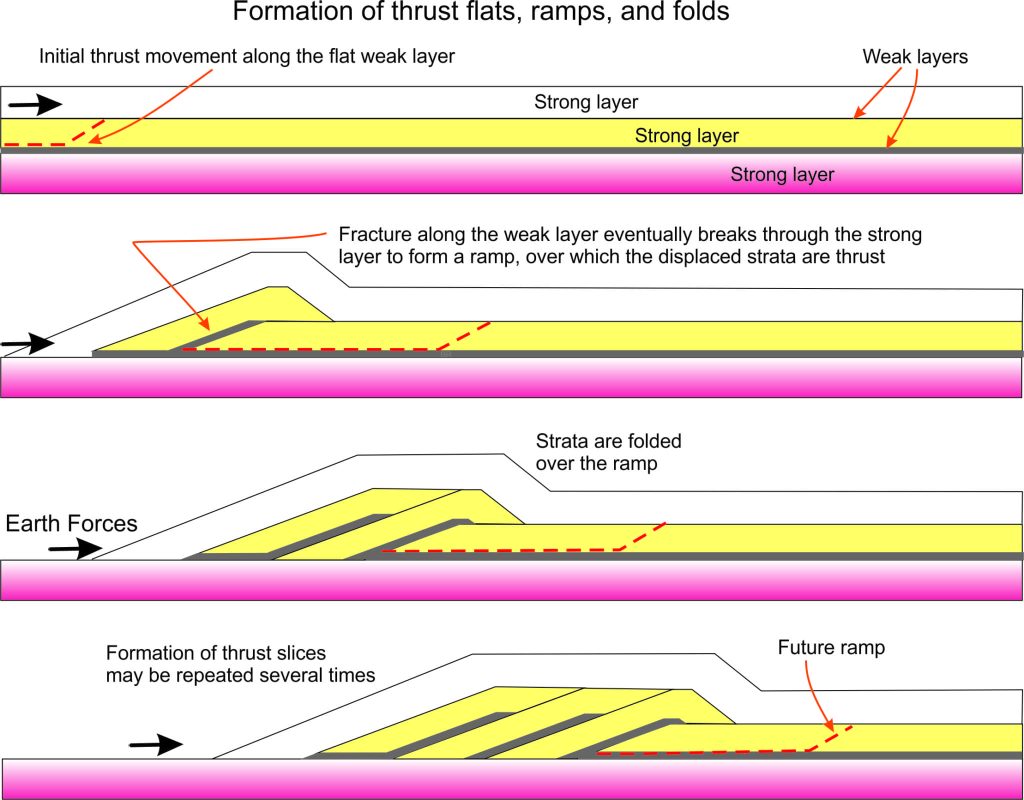
As the cartoon shows, a thrust fault will form when the pushing forces acting on the crust exceed the strength of the rock layers. Rock failure, in the form of a ramp, allows the moving panel of strata (which may be 100s of metres thick) to ride up the ramp and thence across a relatively flat surface. The thrust sheet is commonly folded over the ramp. If the pushing forces continue, a second thrust fault may form beneath the first, resulting in a second panel of strata that carries, piggy-back style, the first thrust panel. This process can be repeated several times, such that the end-product is a stack of thrust sheets, one on top of the other, 100s to 1000s of metres thick. Such stacks are commonly called duplexes. The culmination of this process is a mountain belt.
One of the main identifying traits of thrusting is the repetition of strata: older rocks structurally imposed over younger rocks, that in turn are overlain by younger rocks etc. etc. For Murchison and all those who followed, this was the fundamental problem. Lapworth recognised this at Loch Eriboll, where several thrust panels are stacked one upon the other. Peach and Horne referred to it as a “zone of complication”. Ancient Lewisian gneiss was emplaced in the topmost thrust panel, and beneath this is a repetition of much younger Cambrian sandstone and limestone. This is a classic example of a thrust duplex.
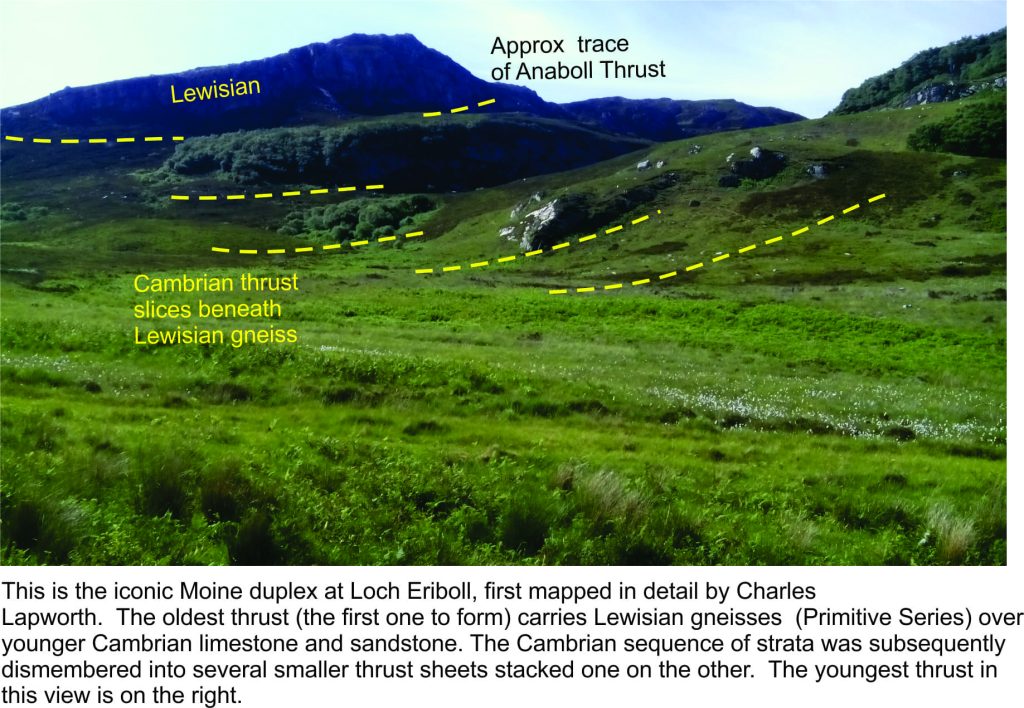
Callaway’s mapping in the Glencoul area showed what has become another classic example of thrust repetition. From the lake shore, Lewisian gneiss is unconformably overlain by Cambrian quartzites (quartz-rich sandstones) and related sedimentary rocks; this is a stratigraphic contact, albeit one in which a great deal of time is missing. However, the gneisses and their overlying Cambrian rocks reappear above the Cambrian strata; the contact here is the Glencoul Thrust (part of the Moine Thrust complex).

The iconic stratigraphic section and exposure of the Moine Thrust at Knockan Crag is designated a Geo-Heritage Site. Peach and Horne, bronzed and looking on approvingly, point the way to a short hike that takes one through the key elements of the Cambrian stratigraphy to the Moine Thrust and overlying panel of ‘Primitive schist’. The thrust occurs above the Durness Limestone where there are excellent examples of mylonite, rock that was ground up and fractured as the thrust fault formed – giving us some insight into the massive forces that generated these structures.
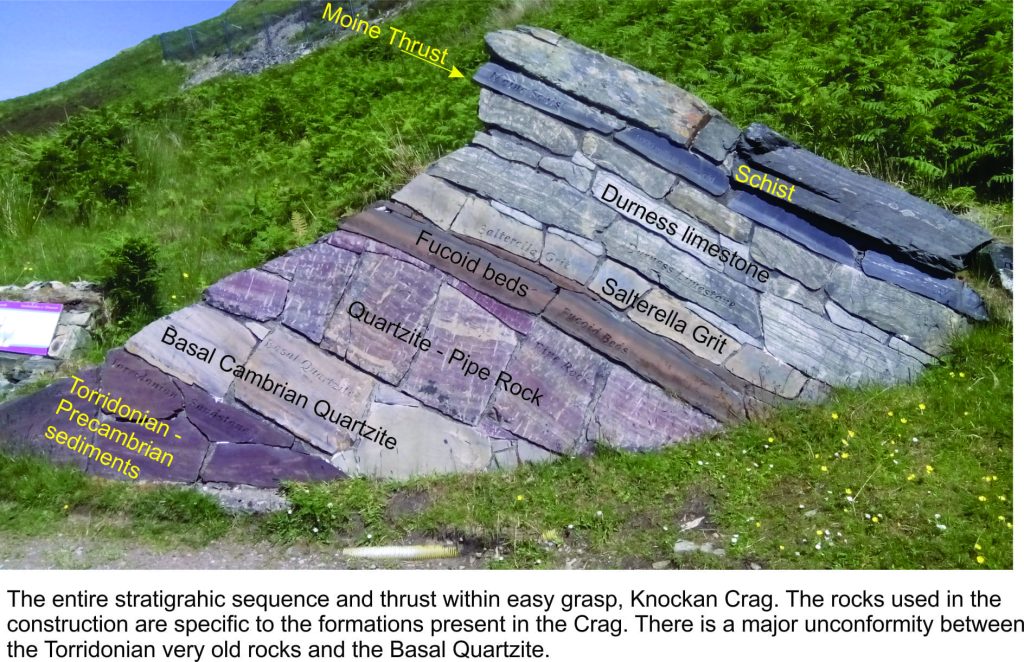
(Click on the images below for a larger view of Knockan Crag stratigraphy)
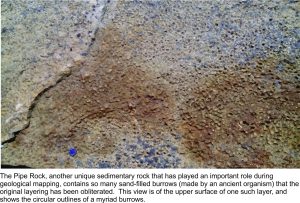
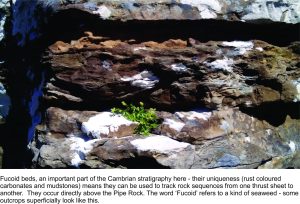
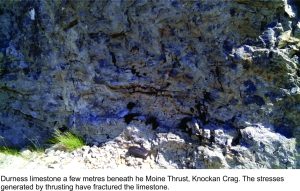
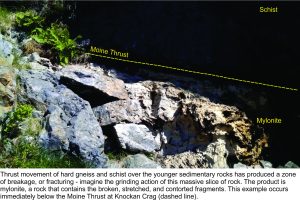
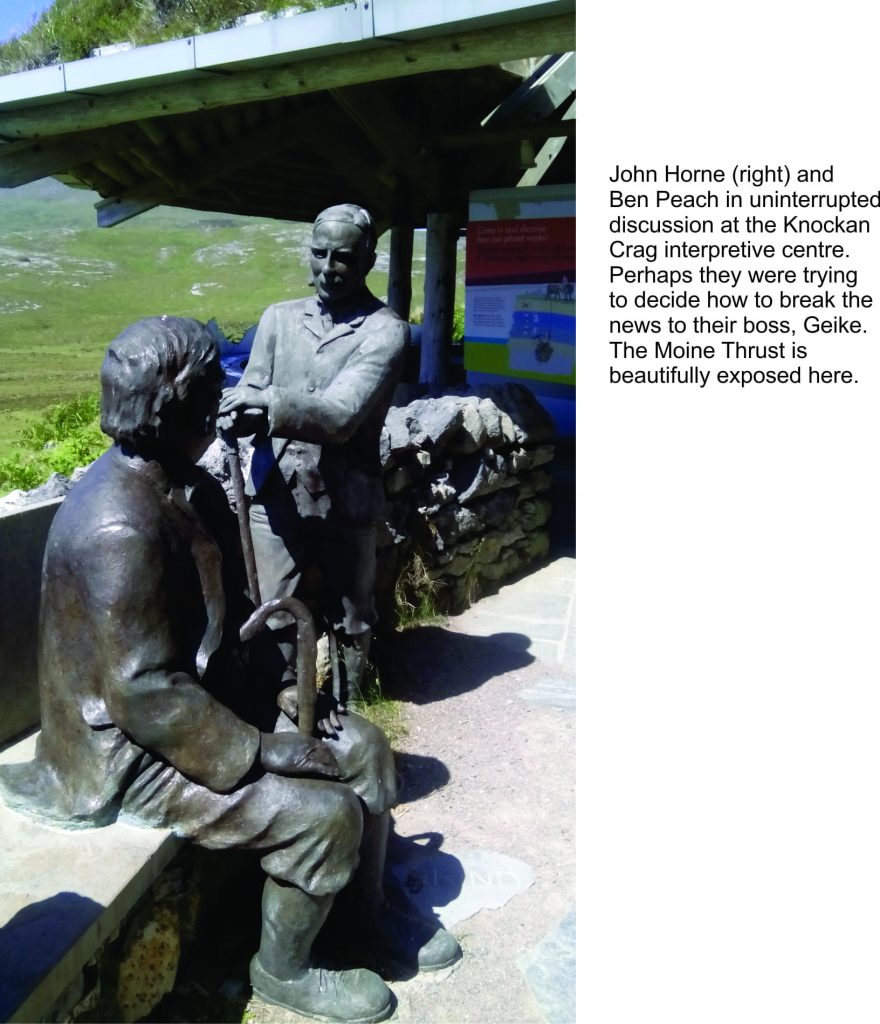
The Moine Thrust was an integral part of a protracted period of mountain building from 475 to 405 million years ago, when three continental plates collided as the intervening Iapetus Ocean was consumed by subduction: Laurentia (now North America and Greenland), Baltica (Scandinavia and northern Europe), and Avalonia (southern England and east Newfoundland). The ancient mountain chain is called the Caledonides, the Roman name for all those unruly Celts. Remnants of these once lofty peaks can be traced from Scandinavia to northwest Scotland and Ireland, eastern Greenland, and the Appalachians of eastern North America.
Our understanding of the Caledonides and mountain belts in general, took a great leap forward with the field work of Nicol, Lapworth and Callaway; the icing on this thrust-cake was provided by Peach and Horne. This story, like many others in the history of science, is interwoven with personal feuds and institutional bias. Arguing against accepted wisdom is always fraught. It is worth remembering the trials of the folk who wage, in their search for truth, against the establishment. So, the next time you put your finger on a thrust fault, spare a thought for those whose common sense and sound scientific reasoning ultimately prevailed.


















2 thoughts on “The Moine Thrust: An idea that unravelled mountains”
Below the first cartoon: “a thrust fault will form when the pushing forces acting on the crust exceed the strength of weak rock layers”.
Shouldn’t this be the strength of the strong rock layers? The essential break is in the strong rock layers and when that occurs the weak layers provide an easy sliding platform.
Thanks for the comment. Strictly speaking that is correct, although it is likely that strain will initially lead to failure along weak layers. So I’ve deleted reference to “weak” to avoid ambiguity. Thanks.